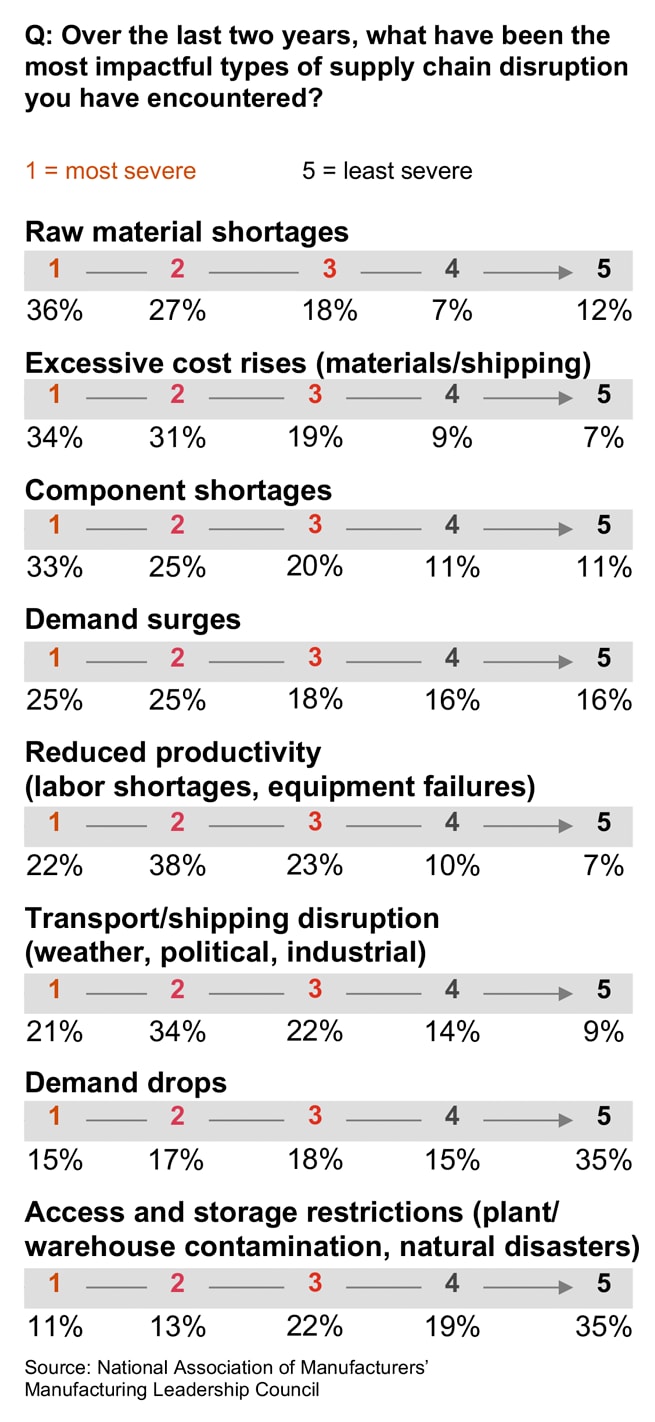

Next Manufacturing: Industry 4.0
New technologies are changing the face of manufacturing—from 3D printing, robotics and the internet of things to autonomous vehicles.
The last two years have rocked global supply chains. The global COVID-19 pandemic triggered worker shortages and supply chain snarls, which were followed by inflation and Russian invasion of Ukraine. Even as manufacturing activity remains resilient overall, these challenges could dampen the possibilities of a larger recovery.
A recent survey carried out by the National Association of Manufacturers’ Manufacturing Leadership Council (MLC) found that nine in ten manufacturers agreed they have suffered significant disruption to their supply chains over the last two years, including in raw material shortages, higher costs for materials and shipping, and component shortages. A separate 2022 PwC survey concurs, finding that more than two-thirds of US manufacturers agree that their suppliers are facing operational issues. Additionally, manufacturers continue to face challenges to fill job openings which could also be impacting their growth as well as contributing to persistent supply chain issues. In fact, nearly half of manufacturers (45%) say that worker shortages have left them unable to take on new business and led to lost revenue opportunities, according to the NAM.
The current supply shortages, bottlenecks, long lead times and rising costs for intermediary inputs are largely the result of unmet demand for goods in an inelastic supply chain environment.
PwC expects global supply-chain disruptions to ease through 2022 as pent-up demand for goods and services softens and as supplies catch up. However, it is likely that supply issues will persist until at least 2023. Indeed, the MLC survey finds that roughly one-third of US manufacturers expect that it will take at least a year for supply disruptions to improve, with 14% believing it will take two years or more.
of manufacturers have experienced supply chain disruption over the last two years
of manufacturers are experiencing severe risks in securing raw materials
of manufacturers’ suppliers are facing operational issues
Over half of manufacturers suffered significant supply chain disruption in the last two years.


The current conditions have weakened every link in the value chain and forced manufacturers to rewrite their supply chain playbook — not only to work around today’s disruptions but also those of the future. The overarching approach to easing these risks is to strengthen resilience and agility.
The following is a seven-step approach to achieving resilience and building agility into operations. These are high-level definitions and are not intended as sequential steps. In fact, they can be carried out on parallel tracks. They are meant to guide supply chain leading practices that support overarching business priorities.
Resilience is the result of a risk-mitigation planning process, a state of readiness that is achieved when plans are put into place to meet large- or small-scale disruptions. Agility is the ability to create as-needed elasticity, and it is a capability built into the design of a supply chain. It’s the ability to execute on resilience plans.
Building a connected, end-to-end value chain means breaking down barriers between functional areas and enabling multifunctional collaboration. All functional teams (e.g., sales and marketing, engineering and design, research and development, manufacturing operations, procurement, pricing strategy) must work together and have visibility into what each is doing for balanced, collaborative and transparent decision-making. A first step is identifying who in the organization are supply-chain influencers and stakeholders; this guides a revamped supply-chain operating model and resiliency planning process.
Building an end-to-end operations value chain does not supplant the traditional supply-chain SCOR model, as some might suppose. Functional teams within the supply chain operating in silos are unlikely to drive change. The current disruption has demonstrated that it's insufficient to optimize within these silos alone. These virtual walls defining the silos need to fall and give way to an operating organization that includes not only traditional silos under the SCOR model (still highly relevant and useful) but also includes all influencers of supply-chain performance working in an orchestrated manner. In fact, nearly one-third of manufacturers say they are moving toward an end-to-end value model, with just 15% still using the SCOR model, according to the MLC survey.
Once supply-chain influencers and stakeholders are brought together, modeling and simulations can identify how to resolve misalignments between market and commercial priorities and traditional supply-chain priorities. Removing silos can also encourage better decision-making that delivers planning and execution decisions based on total end-to-end value chain priorities and leads to improved customer service.
As supply-chain issues persist as a pain point not only for individual companies, but also for national economies, it is becoming increasingly important for companies to find ways to make supply chains more agile and resilient. And, as inflationary and geopolitical pressures continue, improved supply chains will become much more important to help companies contain costs not only for their own businesses, but also for their customers. Based on both the MLC and PwC surveys, it appears as if most manufacturers are making strides to strengthen their supply chains in the current economic headwinds and disruption – as well as those that may arise in the future.


New technologies are changing the face of manufacturing—from 3D printing, robotics and the internet of things to autonomous vehicles.


PwC helps clients in the industrial manufacturing industry address key business issues, potential impacts of climate change initiatives, and global merger and acquisition activity.


For manufacturers, building cyber protection throughout the supply chain has become critical to achieving security, agility and resilience.